
|   |

|   |
 e-mail: leelakaverivenkat@gmail.com Kadamba of Natya Darshan flowered without rambling Photos courtesy: Natya Darshan January 8, 2019 It never rains, it pours! And with so much happening at the same time, my preference was for attending morning discussions, which are generally 'once only' happenings, whereas the chances of catching up with the artists featured in the evening performances, at some other event, are always greater. Natya Darshan's Kadamba - the flowering Path, under its curator Priya Murle, very wisely spread its events with different venues like the Forum Art Gallery, Bharata Kalanjali, Kinsley Manor and the Government Museum - not just highlighting the inter-relationships existing among art disciplines, but also making festival proceedings accessible to people living in different areas. 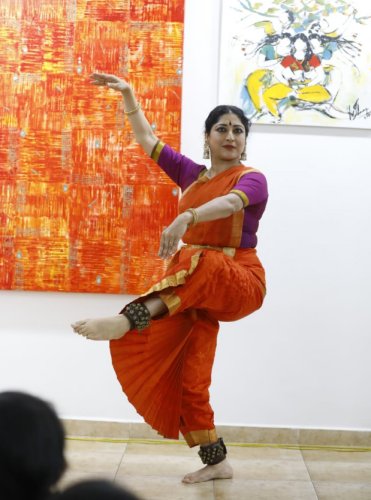 Lakshmi Gopalaswamy 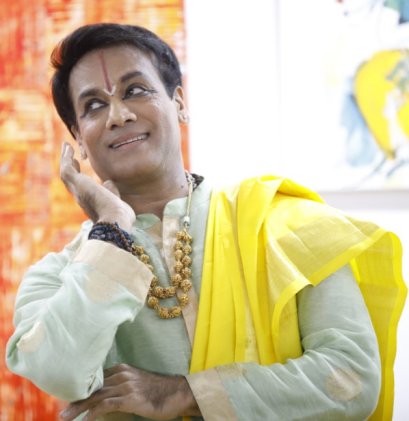 Sathyanarayana Raju To throw light on changes in pedagogical approach to training, in this Bharatanatyam based festival, Jayanthi Subramaniam in a very short demonstration brought out salient features of Guru Adyar Lakshman's teaching. Describing him as 'a traditional Guru with a modern approach', she spoke of her having to unlearn what she had acquired previously while relearning basics under Adyar Lakshman. She underlined his particular emphasis on Anga suddham - how to stand with the two feet turned outwards 180 degrees, the angle at which the shoulder and the wrists were to be held when hands were stretched and how the crossed leg at the back balanced on toes with heels lifted had to be very correct and not held in a way that made 'one look like an injured dog'. Adyar Lakshman's way of describing the aerial route of the hand doing a 'Kitataka tadiginatom' with a circle at the back, almost brushing the nose in front and "coming down like a stone smoothly rolling down a hill" was so clear. Programs were incidental and every class would be treated with the same care where 'assimilating, observing and practicing' was the motto. In the same session, Anita Guha's training revealed a different graph, with guidance from many teachers starting with her mother Karthiyayini Natesan, after which she came under the tutelage of Guru Govindarajan , Guru Radhakrishna and Dr.Ananda Shankar Jayant. Speaking frankly about her attraction for the nritya natakam genre, and the way she related with bhakti oriented themes based on mythology, she demonstrated through her students how after absorbing different influences, she had evolved a methodology for communicating with youngsters (her students are famous for their araimandi perfection) - her teaching bearing fruit with Bharatanjali grooming fine dancers with excellent technique. "No ducks back" she told the tiny tots as they took their stance with a straight back without the lower half sticking out, and her students showed the Natyarambam stance (A of Dance is how she called it). 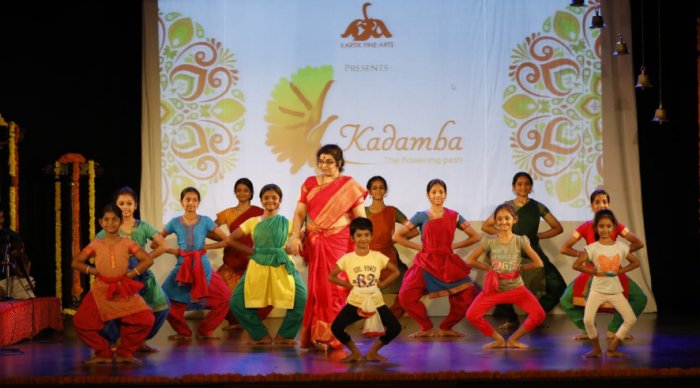 Anitha Guha and young disciples Evolving a laya process from tradition to the present was Bharatanatyam/Kuchipudi Guru Narasimhachari whose approach was articulated by his disciple /wife Vasantalakshmi whose earlier career was as a senior disciple of Guru Adyar Lakshman. Narasimhachari used the jati in ways to enhance the impact of a situation in the composition, as for instance in the Natakuranji Papanasam Sivan Varnam, the guru paying special attention to the point of 'eduppu', and in the charanam line of the same varnam "Nataraja Deva Sachchidananda," the jati suited the string of epithets used to describe Shiva. Similarly the manner in which swaraksharas and the dhrigutaka tom syllables were used for the nritta part ending "Nrityati nrityati Sadasivam" described poetically as "sculpture released into rhythmic motion" in a Swati Tirunal composition, as also the "Baja Payal" segment of the Dhanashri Tillana of Swati Tirunal, which gave place for emphasizing the role of the anklets, were some of the examples, demonstrated by the students of Kalasamarpana Foundation. Who better than Lakshmi Viswanathan to speak on the Pada varnam given her expertise in abhinaya (particularly in sringar) and fluency in articulating her thoughts? She spoke of her early collaboration with Jitendra Krishna of Holland, who having learnt from one of Kittappa Pillai's disciples settled there, has original recordings of the Guru and for Lakshmi who with her scholarship is particularly interested in the old varnam paddhati, this association proved fruitful. Describing the God/King concept, which coming after a very dark period in Tanjore history, became the norm, in the Nayak period (which saw a new flowering of Bharatanatyam) she explained and in her own inimitable fashion interpreted through abhinaya the varnam statement "nee sati dora neevani neranammi naanu" where Sarfoji is praised as Devendradau, as musician, as writer, as ruler of the world. The Prema Bhakti concept, later addressed to deities like Mannargudi Rajagopala when bhakti sringar came in compositions like "Mohamana en meedu" demands subtlety in portrayal. Lakshmi, as is her wont, in humorous sarcasm said that bhakti sringar cannot be trying to embrace the huge Shivalinga passionately - as portrayed by some. The music which is the most significant aspect of a varnam where melody and bhava are important without any recourse to niraval singing, was fitting with Shivasri the vocalist acquitting herself with credit, with the rest of the accompaniment by nattuvangam by Sudarshini, Shivaprasad on mridangam, and Sri Lakshmi on violin. 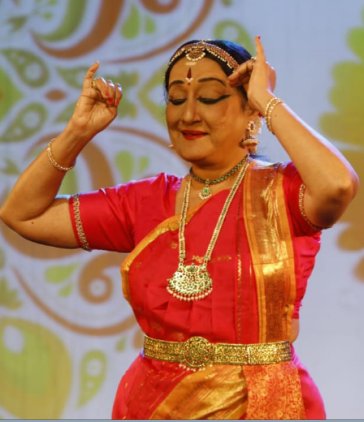 Lakshmi Viswanathan 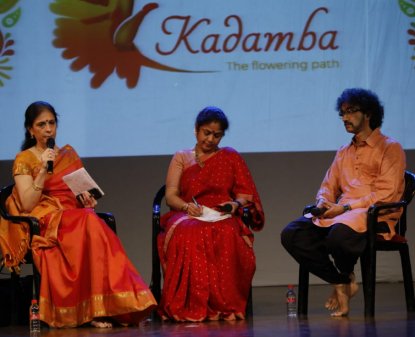 Nalini Prakash, Ananda Shankar Jayant, CP Satyajit Nalini Prakash emphasised that saying Bharatanatyam is therapeutic is different from Bharatanatyam as therapy which involves specialising in movement therapy and in psychological therapy. (Art and science bond here). She was involved with the chronically ill African Americans outside the prison system, whose drastic need for healing, has made her use the language of hastas and navarasa, with the stories as metaphors and symbols to help these deprived patients express themselves. Satyajit having studied in the J. Krishnamurti school where one was encouraged to question everything, wondered why kids who in the Montessori system are taught so differently in school, are not initiated into abhinaya, while learning Bharatanatyam at a much younger age. Pointing to discrepancies in training outlook, Satyajit also spoke of the later years between 15-25 when students yearn to dance, they are forced into a gruelling college routine which has no time for other activities and a zone of conflict emerges right there. "We are all the time developing youngsters with conflicts". Ananda's answer was that the interested student will find a way as she did from a scholarship in Eton to Kalakshetra to learn Bharatanatyam. Having got into "the very male space of the Indian Railway Service," she had right through followed a dual path of bureaucrat and dancer with conviction. She focused on other important issues like how to fund the passion for Bharatanatyam and fuel it. She disagreed with youngsters apologetically calling every performance chance an 'opportunity' one is grateful for. "You are entrepreneurs. Look at art as core competence and strength - as empowerment." She touched on technology in art. While the feel of presence is very necessary for all teaching and learning in Bharatanatyam, technology like her Apps Adavu lessons (being made use of widely all over the world by Bharatanatyam students) can help in economising the leaning curve. Technology cannot give life but by giving life to technology, one can derive some benefit. On the second morning, unable to catch the early 8.30am lecture by Dr. Rama Kausalya on the use of sacred and secular Tamil literature in Bharatanatyam, I was in time however to take in Nandini Ramani's lec/dem on use of Sanskrit and other language poetry in a Bharatanatyam performance. She began with the statement that from Krishna Karnamritam to Krishna Leela Tarangini to Shahaji's copious writings, one knows that Sanskrit and Grantha literature provided fuel for Bharatanatyam performances right from ancient days and that Gurus like the Quartet and Kittappa Pillai were not strangers to Sanskrit literature. Putting the focus on works of Swati Tirunal, who had Vadivelu in his court to create music, the speaker stressed on the composer's use of swaraksharas and the way swara and sahitya were matched like in the Todi Dani Samajendra varnam - in the note 'dha' as placed in the makuta swara, the accenting of which opened up possibilities for the imaginative dancer. Words were limited but laden with possibilities for elaboration by the creative dancer. The best part of the session for me, lay in Nandini's ability to sing, to do the nattuvangam and to dance while demonstrating - a one man squad - an ability that performers today rarely command. When it comes to throwing light on the use of traditional and non-conventional Telugu literature in Bharatanatyam, the obvious choice is the one and only V.A.K Ranga Rao who in his usual manner effortlessly came out with countless examples from the film world - Tamil (Partibhan Kanavu) and Malayalam. His well known criticism levelled against starting the interpretation of a lyric with the Anupallavi (like Netrandi nerattile) was that this strayed from the dominant mood expressed in the Pallavi which the Anupallavi line may not always build on. The speaker dilated on poetic interpretation of the sahitya. He referred to Manmatha Leelai of Haridas in Charukesi, where Vazhuvoor's interpretative approach showed the nayika thinking "Why do I need black kajal in my eyes, when Krishna is already in my eyes." He also gave the example of Kadoor Venkatalakshamma's interpretation telling Krishna that while people called him great because he lifted Mount Govardhan, what of me as consort, who carries you on my chest? The most erotic poetry lends itself to being shown in Bharatanatyam in the most poetic manner. He forbade vulgar interpretations. The problem has always been on the yardstick used to measure vulgarity and auchitya! Padma Subrahmanyam, as the inevitable person to discuss Sculpture and Dance, spoke of how long it took her to finally realise that the Karanas were not poses but represented frozen moments of one movement. In her first production Meenakshi Kalyanam she too had used Karanas as poses. Her understanding of the Natya Sastra meant going to innumerable references in Sanskrit and even the Agamas - for not even Abhinava Gupta's commentary could help her completely. It took years of toil to understand that the Natya Sastra was known in the entire Jambudweepa and it is when she saw how her visualisation of the Karanas for the Sattara temple tallied so completely with the Karna sculptures in Prambanan of Java that she felt she was on the right track. Padma described the Rechakas as the 'gamakas of dance'. Padma's work on Karanas inducted into her Bharatanritya, perhaps marks a way of recalling and adding the Sanskritic tradition of the Natya Sastra sculpted on temple walls, to the regional tradition of the adavu alphabet which constitutes Bharatanatyam. 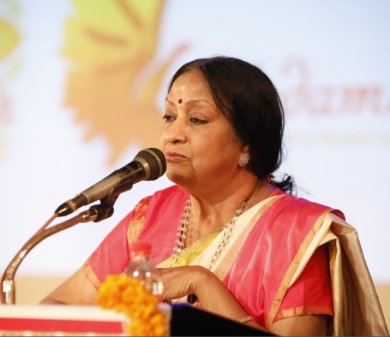 Padma Subrahmanyam 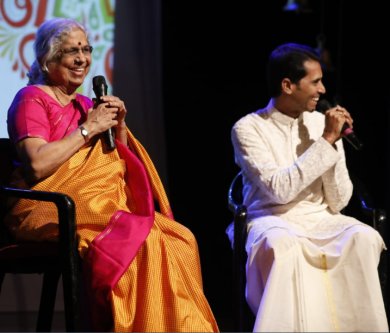 S. Rajeswari and Swamimalai Suresh 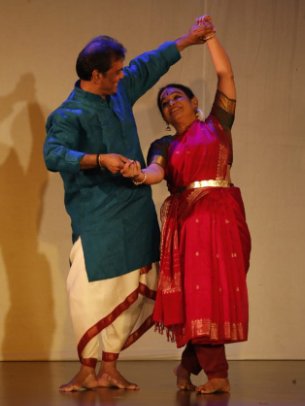 A. Lakshman and Bragha Bessell Bragha Bessell made a very crucial point about lakshanas associated with each of the great characters which the dancer in his or her portrayal needs to bring out and the entire training of a dancer's body is to be able to transcend that body with an awareness where gender plays no role. She chose for her demonstration the Ashtapdi "Kshana madhuna Narayana manugatamanusara Radhike". This song expresses Krishna's passion and the coming together of Radha and Krishna. The delightful conclusion to the two day event was the duo presenting "Rusali Radha, Rusala Krishna, Rusale Gokul Sare". Radha is angry and so is Krishna and in their anger, it seems as if the whole of Gukul reflects their feelings. The pouting, the ched/chad as the Kathak dancer would say and above all its effect on Nature with even the deer, and the peacock and peahen distancing from each other was most effectively brought out and above all one could see the dancers deriving a great deal of fun out of the exchange. A good way to bring down the curtain with kudos for Priya Murle's designing of this edition of Natya Darshan!  Writing on the dance scene for the last forty years, Leela Venkataraman's incisive comments on performances of all dance forms, participation in dance discussions both in India and abroad, and as a regular contributor to Hindu Friday Review, journals like Sruti and Nartanam, makes her voice respected for its balanced critiquing. She is the author of several books like Indian Classical dance: Tradition in Transition, Classical Dance in India and Indian Classical dance: The Renaissance and Beyond. Comments * I enjoyed reading the column Taalam by Leela Venkataraman on Natya Darshan's Kadamba: The Flowering Path in Narthaki. The conference curated by Priya Murle was agreeably a huge success. I would like to clarify some points I made on dance/movement therapy during the panel discussion on Change in Content, Context, and functionality of Bharatanatyam. Dance / movement therapy allows people to connect with the self and with others. It does not prescribe to any specified form of dance - Bharatanatyam or otherwise. As dancers of varied forms, I am sure most of us have understood and experienced first-hand the therapeutic value of dance and how its practice is often a cathartic experience. However, there is a difference between using dance of any form as therapy and dance/movement therapy, which is an entirely different field of practice. The distinction lies in the psychotherapeutic training imparted to a dance/movement therapy practitioner. Dance/movement therapists work with their clients as specially trained clinicians through the body and its movement and also have the skills to facilitate verbal processing among clients during group sessions. In my work at Saint Elizabeths Hospital in Washington DC, my clients primarily comprised a vulnerable population of African Americans. These individuals who committed crimes due to mental illness were serving time in a psychiatric hospital instead of a prison and received treatment for their mental illness. I combined the use of the language of hastas and the navarasas from Bharatanatyam with creative movement during dance therapy groups with these individuals to encourage them to tell their stories using metaphor and symbolism as a non-threatening and effective way to heal from the trauma of mental illness. - Nalini Prakash, BC-DMT, CMA Board Certified Dance/Movement Therapist, Certified Movement Analyst PhD Candidate, Creative Arts Therapy Program, Drexel University, Philadelphia, USA (Jan 11, 2019) Post your comments Please provide your name and email id when you use the Anonymous profile in the blog to post a comment. All appropriate comments posted with name & email id in the blog will also be featured in the site. |